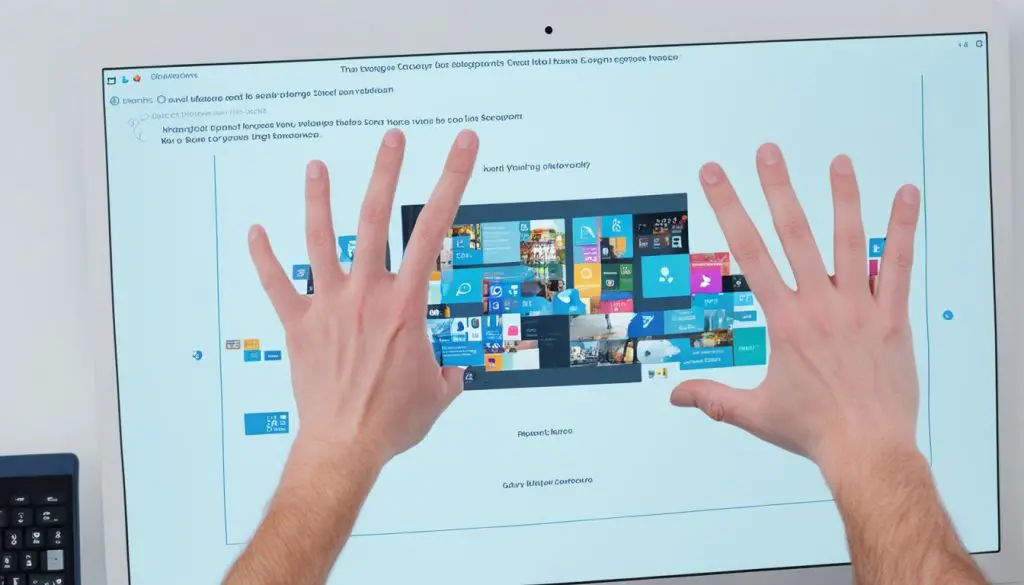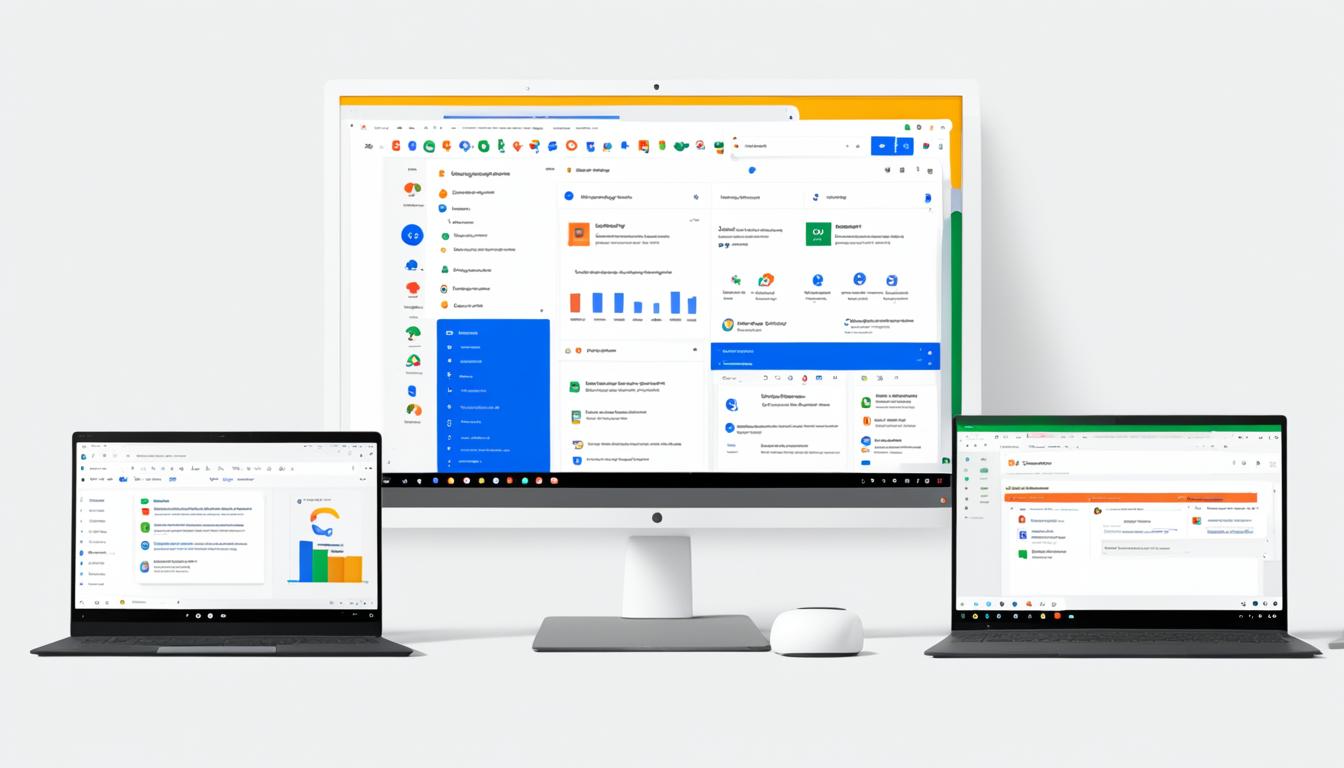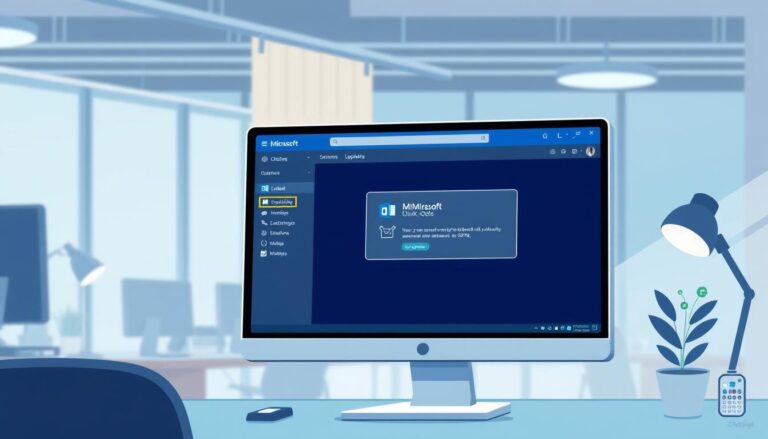Google Workspace vs Microsoft 365: My In-Depth Comparison
Have you ever wondered which cloud-based office suite reigns supreme in boosting productivity and collaboration—Google Workspace or Microsoft 365? As someone who has extensively used both platforms, I found that the choice isn’t as straightforward as it seems. From price points to core applications and unique features, there’s much more than meets the eye in this productivity apps comparison.
In this firsthand business software review, I’ll delve into the nuances that set Google Workspace and Microsoft 365 apart. While both suites facilitate essential business tasks like email management, document creation, and video conferencing via a web browser, each has its unique strengths and shortcomings. Microsoft 365, formerly known as Office 365, boasts powerful desktop applications like Word and Excel for offline access. Meanwhile, Google Workspace, previously branded as G Suite, excels in real-time, cloud-first collaboration through tools like Docs and Sheets.
Choosing between Google apps vs Microsoft Office often comes down to your specific business needs. Whether you prioritize cost-effectiveness, integrated tools, or security features, both platforms offer robust solutions. Microsoft 365’s advanced security features and high base storage might sway some users, while Google Workspace’s scalable plans and innovative third-party integrations make it an appealing choice for others.
Key Takeaways
- Google Workspace pricing ranges from $6 to $18 per user per month, while Microsoft 365 ranges from $6 to $22.
- Both suites offer robust cloud storage, with Microsoft 365 starting at 1TB and Google Workspace ranging up to 5TB.
- Google Meet supports video meetings for 100-500 participants; Microsoft Teams accommodates up to 300 participants.
- Google Workspace excels in real-time collaboration, while Microsoft 365 is known for advanced workflow automation and higher storage.
- Overall, the pricing and features are comparable, with slight advantages in specific areas for each suite.
As I delve deeper into this comparison, you’ll discover the granular details that will guide you to the right choice for your business. Stay tuned for an extensive breakdown of features, pricing, usability, and much more.
Overview of Google Workspace and Microsoft 365
In the modern business environment, cloud collaboration tools have become indispensable. Both Google Workspace and Microsoft 365 stand out as robust options, each offering a comprehensive cloud-based office suite designed to enhance productivity and streamline workflows. This section delves into the core aspects of these platforms, providing a clearer understanding of their offerings and differences.
Introduction to Cloud-Based Office Suites
A cloud-based office suite such as Google Workspace and Microsoft 365 provides organizations with essential tools like email management, document creation, and collaborative spaces. The primary distinction between these suites lies in their approach: Google Workspace emphasizes cloud-native apps designed for seamless collaboration, whereas Microsoft 365 integrates fully installable desktop applications, offering a richer feature set conducive to both online and offline work. For an in-depth comparison, you can check this detailed analysis.
Core Applications and Features
Both platforms host a variety of applications designed to meet diverse business needs. For instance:
- *Google Workspace*: Tools include Gmail, Google Calendar, Google Drive, Google Docs, and Google Meet, focusing on ease of use and real-time collaboration.
- *Microsoft 365*: Familiar applications like Microsoft Word, Excel, Outlook, PowerPoint, and Microsoft Teams, which offer deeper functionality, especially in their desktop versions.
Google Workspace’s collaborative capabilities are a strong appeal, facilitating real-time editing and seamless teamwork. Contrarily, Microsoft 365’s spectrum of tools caters to both collaborative and individual work, enhancing overall productivity. Their detailed features are significant drivers for organizations deliberating between Google Cloud vs Office 365.
Usability and Accessibility
Usability and accessibility are critical when considering cloud-based solutions. Both suites are accessible via web and mobile apps, with Microsoft 365 also offering comprehensive desktop applications. Google Workspace’s apps are intuitive and user-friendly, making them popular among those familiar with Google’s ecosystem. In contrast, Microsoft 365’s advanced functionalities often cater to businesses needing robust desktop app capabilities. This difference in approach can influence productivity and ease of use. For more insights into Microsoft 365, visit this resource.
In conclusion, choosing between these cloud collaboration tools hinges on an organization’s specific requirements and preferences. Whether prioritizing seamless, cloud-native collaboration with Google Workspace, or leveraging the full potential of desktop applications in Microsoft 365, both platforms exemplify efficient productivity solutions.
Pricing Structure Comparison
Choosing between Google Workspace and Microsoft 365 often begins with a close examination of their pricing structures. Both platforms offer a variety of plans to accommodate different business needs, and understanding these options can be crucial for budget-conscious organizations.
Google Workspace Pricing Plans
Google Workspace pricing starts at $6 per user per month for the Business Starter plan, which includes 30GB of storage. Mid-tier options like Business Standard at $12 per user per month offer 2TB of storage, while the Business Plus plan at $18 per user per month upgrades the storage to 5TB.
For enterprises needing extensive features and storage, the Enterprise plan provides customizable options with advanced security tools.
Microsoft 365 Pricing Plans
Microsoft 365 features a more complex pricing structure. Starting with the Business Basic plan at $6 per user per month, it includes key applications like Microsoft Teams. The Business Standard plan costs $12.50 per user per month, offering a full suite of Office apps. For $22 per user per month, the Business Premium plan adds advanced security features.
Microsoft 365’s pricing in the Enterprise tier adjusts based on specific needs, with unlimited storage and capabilities designed for larger organizations.
Cost-Effectiveness for Small Businesses
When evaluating cost-effectiveness for small businesses, Google Workspace and Microsoft 365 present different advantages. With Google Workspace’s straightforward and flexible pricing, small businesses have predictable costs without overwhelming complexity. Its collaboration tools and user-friendly interface make it preferable for teams requiring seamless coordination.
On the other hand, Microsoft 365 features additional integration options with other Microsoft products, which can be significantly advantageous for businesses heavily reliant on Microsoft’s diverse ecosystem. Both platforms ensure above 99% uptime, providing reliability that small businesses can depend on.
Collaboration Tools and Features
As businesses increasingly prioritize digital collaboration, platforms like Google Workspace and Microsoft 365 are at the forefront of providing robust tools to foster teamwork and productivity. Both have distinct approaches and strengths, which cater to varying organizational needs.

Real-Time Collaboration in Google Workspace
Google Workspace shines in the realm of real-time collaboration. Tools such as Google Docs, Sheets, and Slides allow multiple users to edit simultaneously, providing instant updates and fluid synchronization. Features like in-app chat, comments, and direct editing create a seamless, interactive environment for teams dispersed across different locations. This emphasis on real-time collaboration is one of the reasons Google Workspace is favored by innovative companies like Airbus, who prioritize efficient and dynamic workflows.
Microsoft 365’s Traditional Collaboration Approach
On the other hand, Microsoft 365 promotes a more traditional collaboration approach with robust tools such as co-authoring in Word, Excel, and PowerPoint. This suite excels with features like track changes, commenting, and live presentations. It marries the familiarity of Microsoft’s legacy applications with powerful collaborative capabilities, making it suitable for corporations with well-established workflows. Microsoft Teams further boosts collaboration with comprehensive tools for chat, video conferencing, and file-sharing, essential for hybrid work environments.
Third-Party Integrations
Google Workspace stands out with its wide-ranging compatibility with numerous third-party integrations. Users can seamlessly connect with a variety of non-native apps, enhancing flexibility and a rich ecosystem. This ease of integration aligns well with Google’s vision of a connected, cloud-based workspace. In contrast, while Microsoft 365 offers substantial third-party integrations, its ecosystem often prefers compatibility with native applications like Dynamics 365 and Azure. This can make accessing tools like Google Drive relatively less straightforward from a Microsoft 365 account.
In summary, when deciding between these two robust platforms, consider the specific collaboration needs and existing digital ecosystem of your organization. Google Workspace’s real-time collaboration tools and extensive third-party integrations cater well to dynamic and innovative workplaces. Meanwhile, Microsoft 365’s comprehensive feature set and traditional collaboration approach are better suited for organizations with complex, structured workflows.
Security and Data Recovery
When utilizing cloud-based office suites like Google Workspace and Microsoft 365, security is a paramount concern. Both platforms incorporate robust security features to protect user data and ensure operational integrity. Google Workspace leverages AI for threat detection and includes essential tools such as two-step verification, data loss prevention (DLP), and encryption. Recently, Google enhanced its security insights with VirusTotal, aimed at Gmail and Chrome log events for Enterprise and Education versions.
Google Workspace Security Features
Google Workspace offers comprehensive security protocols that include DLP, encryption, two-factor authentication (2FA), and detailed security audit logs. These measures provide strong protection against unauthorized access and data breaches. An additional layer of security is provided by VirusTotal, which offers advanced threat protection for certain Google Workspace plans. This emphasis on security ensures that businesses can operate with confidence, knowing their data is well-protected.
Microsoft 365 Security Enhancements
Microsoft 365 also implements advanced threat protection, featuring mechanisms such as safe links and attachment scanning, designed to prevent phishing attacks and malware infections. The suite provides several security features akin to those of Google Workspace, including access controls and data encryption. By integrating tools like advanced eDiscovery and Litigation Hold, Microsoft 365 offers comprehensive compliance and security measures that are particularly beneficial for industries with strict regulatory requirements.
Data Recovery Capabilities
In terms of data recovery capabilities, both Google Workspace and Microsoft 365 offer efficient solutions to restore lost or deleted data. Google Workspace allows users to recover deleted files within a 30-day window, with the option for extended archival using Google Vault. Similarly, Microsoft 365 offers a file history feature that also spans 30 days, complemented by its advanced eDiscovery and Litigation Hold functionalities to ensure data compliance and recovery. For optimal data protection, it is essential for users to actively manage their data security and consider third-party backup solutions when necessary.
Both platforms mandate a proactive approach to data protection. Continuous management and regular updates to security protocols are crucial for safely leveraging these cloud-based office suites. For more insights on leveraging Microsoft 365 for effective data management and security, you can explore resources like this extensive guide on Microsoft Outlook.
FAQ
What are the main differences between Google Workspace and Microsoft 365?
How do the pricing structures of Google Workspace and Microsoft 365 compare?
Which suite offers better productivity apps?
Can small businesses benefit from using either Google Workspace or Microsoft 365?
How does Google Workspace support real-time collaboration?
What kind of collaboration tools does Microsoft 365 offer?
How do third-party integrations differ between Google Workspace and Microsoft 365?
What security features are included in Google Workspace?
What security enhancements does Microsoft 365 provide?
Are there any differences in data recovery capabilities?
- About the Author
- Latest Posts
Mark is a senior content editor at Text-Center.com and has more than 20 years of experience with linux and windows operating systems. He also writes for Biteno.com

